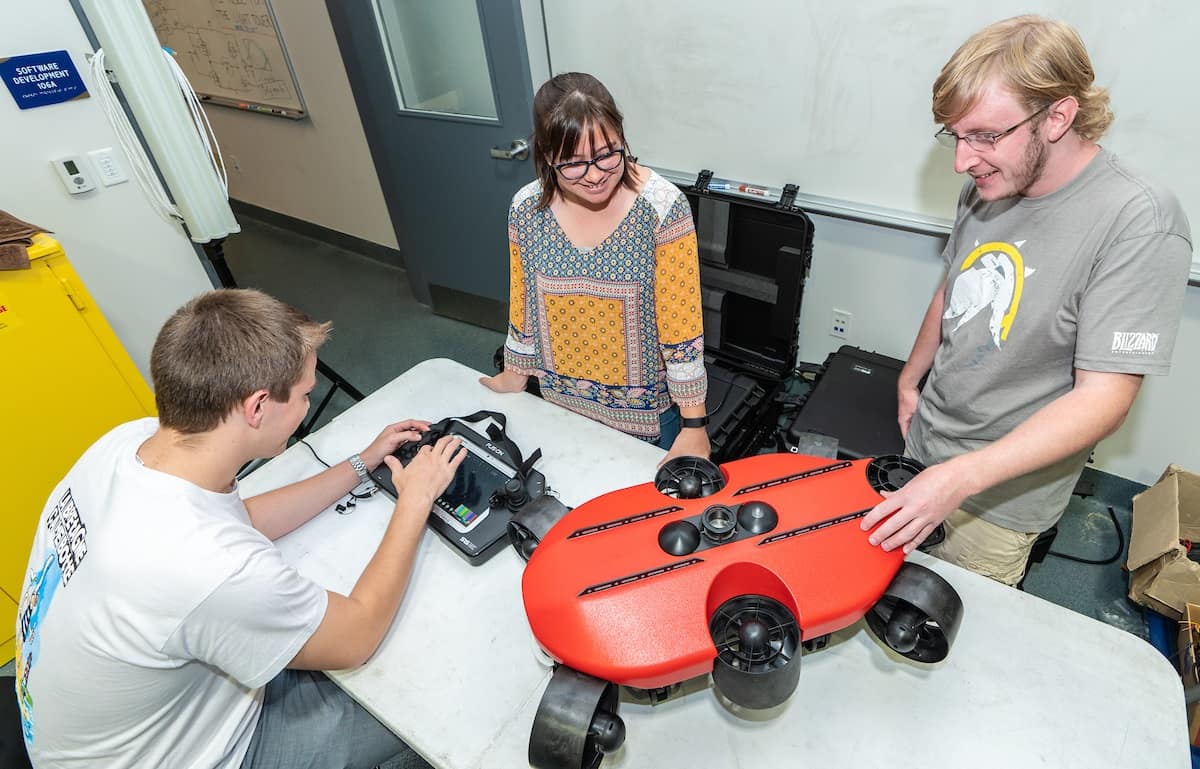Research Submarine Rolls into the MicaPlex

Why does Embry-Riddle own a new submarine? Brian Butka, associate professor of electrical and computer engineering is quick to clarify that it’s a research submarine – not a military-scale vessel.
The 100-pound sub, located in the new Robotics and Autonomous Systems Laboratory at Embry-Riddle’s John Mica Engineering and Aerospace Innovation Complex (MicaPlex), will inform efforts to improve communication between unmanned underwater vehicles and unmanned surface vessels.
“It’s hard to send data underwater,” Butka explained. “When you have a submarine or a boat in the water that has electric thrusters, that noise interferes with sonar. We’re using the noise to send data.”
The work is part of a three-pronged project at Embry-Riddle, supported by a $900,000 research grant from the U.S. Office of Naval Research (ONR). For his part, Butka is developing advanced communication systems for unmanned surface vehicles (USVs).
Eric Coyle, associate professor of mechanical engineering and principal investigator on the ONR project, said it’s “an incredibly difficult thing to communicate underwater. Brian had the idea to actually use the motors on vessels to communicate underwater.”
Many smaller aquatic vehicles use brushless motors that operate in a pulsed fashion, at varying motor speeds controlled by a signal known as pulse-width-modulation. Butka’s proprietary communication technique encodes low data-rate signals using higher-frequency pulses generated by the engine’s thrust, which sounds like noise.
“While obviously the presence of the vehicle is recognizable,” Coyle explained, “the fact that it’s communicating could be hidden.”
Embry-Riddle filed a provisional patent application related to this research, entitled “Communication in Fluid Medium Using Motor Modulation,” on Aug. 13, 2018.
Coyle’s part of the research project focuses on improving perception systems for USVs. Specifically, he’s leveraging short-and long-range detection, classification and speed estimations of maritime objects to enhance situational awareness.
Another team member, Patrick Currier, associate professor of mechanical engineering, has built a software tool to simulate the performance of different energy systems – especially hybrid engines augmented by other power sources such as batteries, wind or solar – to improve the efficiency of USVs.
The new Embry-Riddle research submarine is a Fusion model from Strategic Robotic Systems, which features a variety of underwater sensors, including a forward-looking multibeam-sonar, a side-scan sonar, HD video and lighting. Butka was able to acquire it after he applied for and won a highly competitive ONR award through the Defense University Research Instrumentation Program. To test surface vessel-to-submarine communication strategies, the little sub will be loaded onto Embry-Riddle’s 16-foot USV, Minion, for research trips on the Halifax River.
Minion will also support efforts to integrate many different types of sensors, from cameras to LIDAR (laser-range finders), to improve perception systems, Coyle said. This part of the research project – presented by Coyle and his graduate students David Thompson and Jeremy Brown at a scholarly conference last December – involves a method for mapping objects in the water using LIDAR and processes borrowed from computer vision and computational geometry.
The Robotics and Autonomous Systems Laboratory in Embry-Riddle’s MicaPlex features a motion-capture system offering sub-centimeter accuracy as well as sensor and communications payloads on robotics platforms for proof-of-concept testing. Other features of the lab include a Software Development and Systems Testing Suite and a high-bay work area for indoor flight testing.

 Ginger Pinholster
Ginger Pinholster